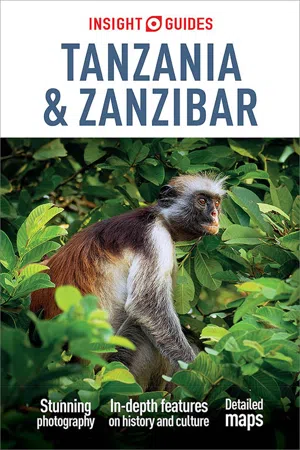
- 280 pages
- English
- ePUB (mobile friendly)
- Available on iOS & Android
Insight Guides Tanzania & Zanzibar (Travel Guide eBook)
About this book
Insight Guide to Tanzania & Zanzibar is a pictorial travel guide in a magazine style providing answers to the key questions before or during your trip: deciding when to go to Tanzania & Zanzibar, choosing what to see, from exploring Stone Town to discovering Ruaha National Park or creating a travel plan to cover key places like Mount Kilimanjaro, Serengeti National Park. This is an ideal travel guide for travellers seeking inspiration, in-depth cultural and historical information about Tanzania & Zanzibar as well as a great selection of places to see during your trip.
The Insight Guide Tanzania & Zanzibar covers: Dar es Salaam, The North Coast and Usambara, Arusha and Kilimanjaro, The Northern Safari Circuit, Western and Central Tanzania, Southern Parks and Tanzam Highway, Mbeya and Lake Nyasa, The South Coast, Zanzibar and Pemba.
In this travel guide you will find:
IN-DEPTH CULTURAL AND HISTORICAL FEATURES
Created to explore the culture and the history of Tanzania & Zanzibar to get a greater understanding of its modern-day life, people and politics.
BEST OF
The top attractions and Editor's Choice highlighting the most special places to visit around Tanzania & Zanzibar.
CURATED PLACES, HIGH QUALITY MAPS
Geographically organised text cross-referenced against full-colour, high quality travel maps for quick orientation in Pemba, Dar es Salaam and many more locations in Tanzania & Zanzibar.
COLOUR-CODED CHAPTERS
Every part of Tanzania & Zanzibar, from Usambara to Lake Nyasa has its own colour assigned for easy navigation.
TIPS AND FACTS
Up-to-date historical timeline and in-depth cultural background to Tanzania & Zanzibar as well as an introduction to Tanzania & Zanzibar's Food and Drink and fun destination-specific features.
PRACTICAL TRAVEL INFORMATION
A-Z of useful advice on everything from when to go to Tanzania & Zanzibar, how to get there and how to get around, as well as Tanzania & Zanzibar's climate, advice on tipping, etiquette and more.
STRIKING PICTURES
Features inspirational colour photography, including the stunning Kilwa Kisiwani and the spectacular Ngorongoro Crater.
Frequently asked questions
- Essential is ideal for learners and professionals who enjoy exploring a wide range of subjects. Access the Essential Library with 800,000+ trusted titles and best-sellers across business, personal growth, and the humanities. Includes unlimited reading time and Standard Read Aloud voice.
- Complete: Perfect for advanced learners and researchers needing full, unrestricted access. Unlock 1.4M+ books across hundreds of subjects, including academic and specialized titles. The Complete Plan also includes advanced features like Premium Read Aloud and Research Assistant.
Please note we cannot support devices running on iOS 13 and Android 7 or earlier. Learn more about using the app.
Information
Table of contents
- How To Use This E-Book
- Texas’s Top 10 Attractions
- Editor’s Choice
- Introduction: The Stuff of Legends
- People
- Decisive Dates
- The Earliest Inhabitants
- Swahili Traders
- Imperial Ambitions
- The Colonial Era
- Independence
- Music, Dance and Art
- The Lie of the Land
- Safari
- Mammals
- Insight: Endangered and endemic wildlife
- Birds
- Tanzania’s Reptiles
- Introduction: Places
- Introduction: Dar ES Salaam
- Introduction: The North Coast and Usambara
- Introduction: Arusha and Kilimanjaro
- Introduction: The Northern Safari Circuit
- Insight: Maasai: nomads of the plains
- Introduction: Western and Central Tanzania
- Introduction: Southern Parks and Tanzam Highway
- Introduction: Mbeya and Lake Nyasa
- Introduction: The South Coast
- Introduction: Zanzibar and Pemba
- Insight: The Swahili
- Transportation
- A-Z: A Handy Summary of Practical Information
- Language
- Further Reading